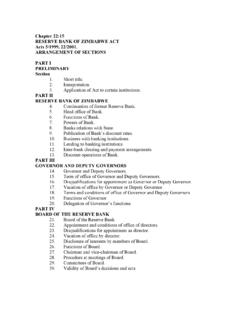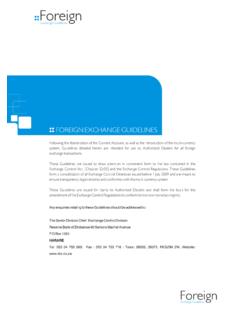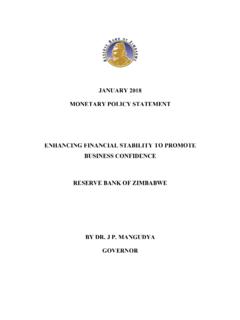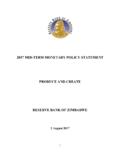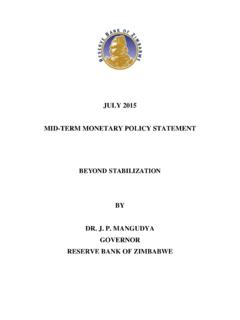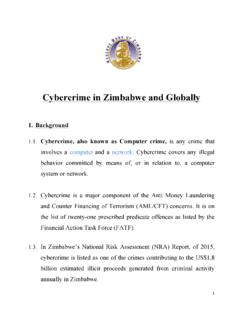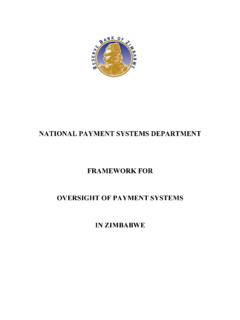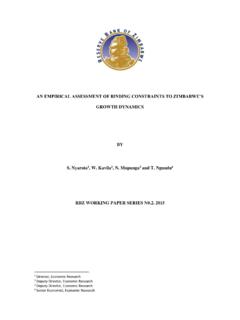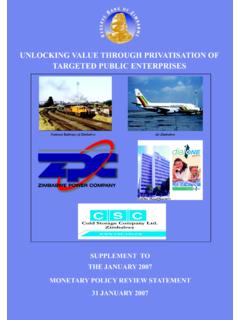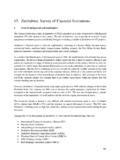Transcription of MONETARY POLICY STATEMENT - Reserve Bank of …
1 MONETARY POLICY STATEMENT ISSUED IN TERMS OF THE Reserve bank OF zimbabwe ACT CHAPTER 22:15, SECTION 46 BY DR. DHLIWAYO ACTING GOVERNOR Reserve bank OF zimbabwe JANUARY 2014 2 TABLE OF CONTENTS TABLE OF CONTENTS .. 2 Tables .. 4 Figures .. 4 INTRODUCTION .. 5 Current Challenges .. 5 ROLE OF THE Reserve bank OF zimbabwe .. 9 Banker to Government .. 10 Lender of Last Resort (LOLR) .. 10 Interbank Market .. 11 EXTERNAL SECTOR DEVELOPMENTS .. 13 International Remittances .. 14 OVERVIEW OF THE BANKING SECTOR .. 15 Architecture of the Banking Sector.
2 15 Financial Intermediation .. 16 Deposits, Loans and Advances .. 16 Sectoral Distribution of Credit .. 18 Non-Performing Loans (NPLs) .. 19 Current Developments in Banking Sector Capitalisation .. 21 Risk Management and Establishment of Mortgage Financing .. 22 Supervisory Cooperation .. 24 POLICY MEASURES AND ADVICE .. 26 Lender of Last Resort .. 27 Issuance of Treasury Bills .. 28 3 Banking Sector Capitalization: Way Forward .. 28 Basel II Implementation .. 31 Prudent Deployment of Capital and Liquidity .. 32 Consolidations and Mergers.
3 32 Insider Loans and Non-Performing Loans .. 34 Credit Reference Bureaus .. 36 bank Charges and Lending Rates .. 38 Enhancement of Supervision through Amendment to the Legal Framework .. 40 Long term Funding .. 42 Financial Inclusion .. 42 Electronic Payments and Usage of Cards .. 43 Regulation of Payment System .. 45 Promotion of SMEs and Community Development .. 45 Gold Mobilisation .. 47 Support to the Small Scale Gold Miners .. 49 Monitoring of Gold Buying Operations .. 50 Gold Bonds .. 51 Timeous Repatriation of Export Receipts.
4 51 Accounting for Tourism and FDI Receipts .. 52 Opening of bank Accounts by Business Enterprises .. 53 Pyramid Schemes .. 54 Continued Use of Multiple Currencies .. 55 Introduction of Additional Currencies Under The Multiple Currency Framework .. 55 CONCLUSION .. 56 4 Tables Table 1: New Capital Thresholds .. 29 Table 2: Exchange Control Flagging Framework for Exporters .. 52 Figures Figure 1: Vicious Liquidity Cycle .. 7 Figure 2: Average Monthly RTGS Account Balances 2012 & 2013 (US$M) .. 12 Figure 3: Merchandise Trade Jan Nov 2013 US$M.
5 13 Figure 4: Sectoral Contribution to Banking Sector Assets .. 16 Figure 5: Banking Sector Loans and Deposits as at 31 December, 2013 .. 17 Figure 6: Loans to Deposits Ratio .. 18 Figure 7: Sectoral Distribution of Credit .. 19 Figure 8: Banking Sector Non Performing Loans .. 21 Figure 9: Securitization Framework .. 24 5 INTRODUCTION 1. My maiden MONETARY POLICY STATEMENT as Acting Governor, is issued in terms of Section 46 of the Reserve bank Act (Chapter 22:15). This follows the strategic postponement of the 2013 Mid-Term MONETARY POLICY STATEMENT , which was necessitated by the need to allow the National Budget to set the fiscal POLICY tone.
6 2. Nevertheless, I present this MONETARY POLICY STATEMENT at a time when the country s economic landscape is facing increasing challenges. Notably, the economic slow-down currently experienced, has been magnified by subdued external demand coupled with the deterioration in domestic macroeconomic conditions. 3. Despite these attendant challenges, I remain optimistic that the economic prospects for zimbabwe will not disappoint, provided we decisively and holistically implement all the ingredients as embodied in Zim-Asset.
7 Current Challenges 4. The country remains saddled with the following attendant challenges among others: 6 i. A severe and persistent liquidity crunch which has made it very difficult for local productive sectors to access sufficient credit to oil the wheels of our economy; ii. Lack of competitiveness of locally produced goods due to high costs of production resulting in the huge importation of finished goods, hence the widening current account deficit; iii. Infrastructure bottlenecks especially around key economic enablers such as energy, transport, communication.
8 These bottlenecks have eroded of viability and competitiveness of local producers in key economic sectors; and iv. Inadequate and often erratic service delivery from parastatals and local authorities. 5. These challenges have resulted in low industrial capacity utilization, accentuated by widespread company closures, deterioration in the external sector position, and rising formal unemployment. 6. Importantly, the deterioration in both domestic and external macroeconomic conditions, and the resultant deepening of liquidity shortages has resulted in a vicious liquidity cycle.
9 7 7. The vicious liquidity cycle depicted below has been compounded by international commodity price deflation that has had negative repercussions on export earnings. Figure 1: Vicious Liquidity Cycle 8. As such, the country s high commodity dependence has conspired with huge import absorption to drain the banking sector of the liquidity largely realized from the following key sources: Lack of competitiveness of products Declining capacity utilization and limited corporate sector viability Low export earnings & high import dependence and unemployment Low liquidity levels in the economy Increased banking sector vulnerabilities including credit crunch Limited deposits and credit availability leading to high costs of funds 8 Export earnings; Diaspora remittances; Offshore credit facilities; Foreign Direct Investment (FDI); and Portfolio investment inflows.
10 9. These negative developments have magnified liquidity shortages in the economy with increased banking sector vulnerabilities, particularly in the absence of an effective lender of last resort. Against this background, this MONETARY POLICY STATEMENT attaches great prominence on measures aimed at maintaining the stability of the banking sector whilst at the same time enhancing its key intermediary role. 10. In this regard, the theme of this MONETARY POLICY STATEMENT is the restoration of the role of the Central bank in efforts to enhance financial intermediation.
